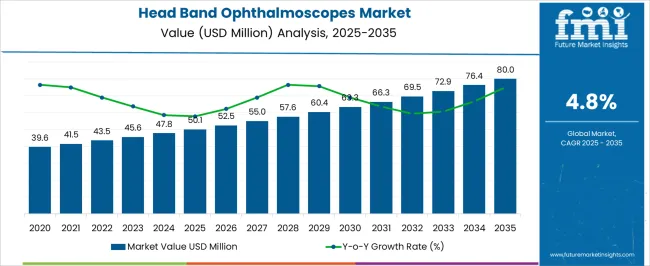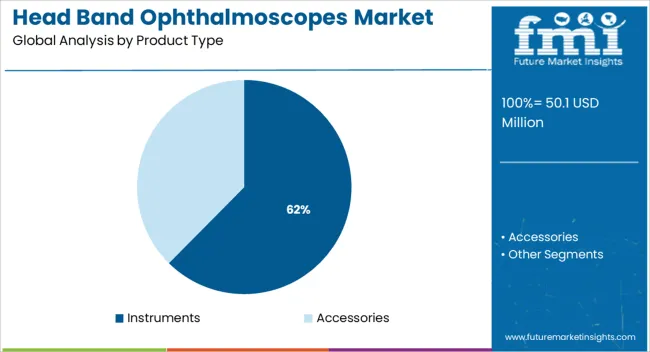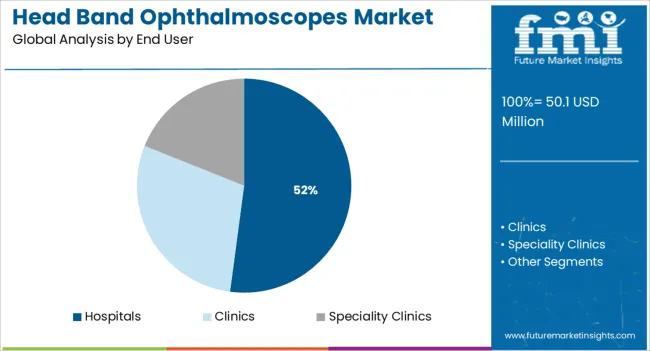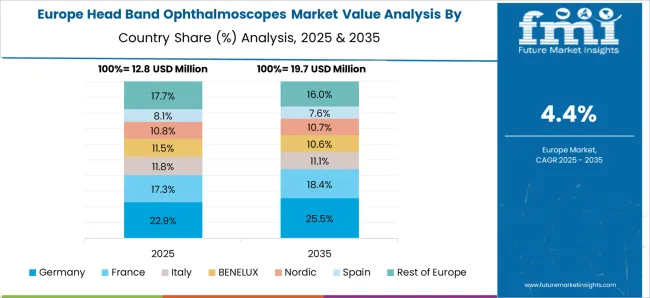The Head Band Ophthalmoscopes Market is estimated to be valued at USD 50.1 million in 2025 and is projected to reach USD 80.0 million by 2035, registering a compound annual growth rate (CAGR) of 4.8% over the forecast period.

| Metric | Value |
|---|---|
| Head Band Ophthalmoscopes Market Estimated Value in (2025E) | USD 50.1 million |
| Head Band Ophthalmoscopes Market Forecast Value in (2035F) | USD 80.0 million |
| Forecast CAGR (2025 to 2035) | 4.8% |
The head band ophthalmoscopes market is witnessing a sustained growth trajectory fueled by increasing demand for high-precision ophthalmic diagnostics and the continued modernization of clinical infrastructure. Surgeons and ophthalmologists are prioritizing hands-free and ergonomically balanced diagnostic devices that offer superior illumination and visualization, particularly in surgical and low-light conditions. Technological advancements such as LED-based illumination, customizable headgear, and enhanced optics are improving diagnostic accuracy and operational comfort.
Additionally, the global rise in eye disorders including diabetic retinopathy, glaucoma, and age-related macular degeneration is expanding procedural volumes, thereby driving device adoption. Government initiatives supporting improved access to vision care, combined with ongoing investments in specialty clinics and multispecialty hospitals, are further influencing procurement patterns.
Market momentum is also being supported by training and academic institutions adopting these tools for standardized instruction. Future growth opportunities lie in wireless configurations, rechargeable energy systems, and integration with imaging platforms, especially as patient-centric diagnostics become standard in ophthalmology.
The market is segmented by Product Type and End User and region. By Product Type, the market is divided into Instruments and Accessories. In terms of End User, the market is classified into Hospitals, Clinics, and Speciality Clinics. Regionally, the market is classified into North America, Latin America, Western Europe, Eastern Europe, Balkan & Baltic Countries, Russia & Belarus, Central Asia, East Asia, South Asia & Pacific, and the Middle East & Africa.

The instruments segment is anticipated to dominate the product type category by contributing 62.4% of total revenue in 2025. This leading position is driven by the clinical demand for precision-engineered ophthalmoscopic tools that deliver consistent optical clarity and durable performance in repetitive diagnostic workflows.
Hospitals and specialty clinics have prioritized the procurement of these instruments due to their adaptability across multiple eye care procedures and patient demographics. Continuous innovation in optics, illumination systems, and ergonomic design has enhanced usability while reducing fatigue for practitioners during extended use.
Furthermore, manufacturers have expanded their offerings with sterilizable components and customizable fit adjustments, which are becoming essential in infection-controlled environments. The instruments category’s sustained dominance is reinforced by its critical role in both primary and advanced retinal examinations, making it indispensable in modern ophthalmic diagnostic settings.

Hospitals are projected to hold a 52.1% share of total revenue in 2025 within the end user category, making them the most prominent consumers of head band ophthalmoscopes. This dominance is being propelled by the comprehensive diagnostic and surgical needs of hospital-based ophthalmology departments, where accurate visualization tools are essential across a broad spectrum of conditions.
Institutional buying patterns have favored integrated diagnostic platforms with advanced visualization capabilities, reinforcing the demand for these head-worn instruments. In high-volume clinical settings, their role in enhancing workflow efficiency and diagnostic precision has positioned them as a critical investment.
Government-funded eye care programs and national health missions are also directing procurement toward hospitals, especially in emerging markets where access to specialized diagnostic equipment is being scaled up. With hospitals serving as referral centers for complex ophthalmic cases, the segment’s leadership is expected to remain robust through continued upgrades and training-based equipment utilization.
The prevalence of eye-related conditions such as age-related macular degeneration, cataracts, refractive error, and diabetic retinopathy is a major factor in the growth of the global headband ophthalmoscope market. In the United States alone, 7.7 million people have diabetic retinopathy, and 24 million people have cataracts, according to estimates from the National Eye Institute.
By the end of 2035, it is predicted that nearly 11.3 million people will have diabetic retinopathy and 38.7 million people will be affected by cataracts. In addition, the development of the worldwide headband ophthalmoscopes market is also fueled by other factors including technological development and improved healthcare infrastructure.
Since its inception for the purpose of producing a novelty product on the market, a steady improvement in technology has been observed. The market for headband ophthalmoscopes will develop due to the increase in eye-related ailments on the rise, along with greater penetration of IT.
The expansion of the global market for headband ophthalmoscopes is also being fueled by other factors including technological development and improved healthcare infrastructure.
The expansion of the market is expected to be constrained by generic competition and severe requirements for product approval. Other significant market limitations are the high costs of research and development associated with the manufacture and development of headband ophthalmoscopes. In addition, there are several factors that are impeding the market expansion of headband ophthalmoscopes, including their usability complexity and a lack of qualified professionals.
The most effective and practical variation of the conventional ophthalmoscope is the binocular indirect headband ophthalmoscope (laser indirect ophthalmoscope). To improve demand in the worldwide market, manufacturers are adding lasers to headband ophthalmoscopes.
The market for headband ophthalmoscopes is dominated by North America because of the rising incidence of eye-related ailments and the presence of highly competent physicians. The market for headband ophthalmoscopes is also expanding due to additional factors including the availability of high-tech healthcare facilities and a suitable reimbursement environment. Due to the aforementioned factors, North America is anticipated to have a 34.1% market share for headband ophthalmoscopes in 2025.

Owing to the increasing research and development initiatives, Europe is now the second-largest market for headband ophthalmoscopes. Furthermore, a number of important businesses are concentrating on bolstering their position in Europe through acquisitions, expansions, product launches, and approvals.
As investment prospects for industry participants active in the headband ophthalmoscopes market increase, the demand for headband ophthalmoscopes in Europe is anticipated to rise. As a result, in 2025, Europe is anticipated to have a 27.6% market share for headband ophthalmoscopes.
Asia Pacific is predicted to account for a significant portion of the global headband ophthalmoscopes market due to its enormous population and rising governmental and private investment in research and development. As a result, it is anticipated that Asia Pacific will account for 25% of the market for headband ophthalmoscopes in 2025.
As a result of the extremely competitive environment, several new firms are entering the market with unique technologies.
Example:
Businesses involved in the Head Band Ophthalmoscopes industry are now more engaged with launching strategies like targeted marketing, CSR initiatives, etc along with new inventions as a way to increase their global prominence. The fact that these businesses are now aiming to handle a certain business-related activity in a nation that offers advantageous legislation is a clearly discernible trend that is being noted across the board.
Example:
| Report Attribute | Details |
|---|---|
| Growth Rate | CAGR of 4.8% from 2025 to 2035 |
| Base Year for Estimation | 2024 |
| Historical Data | 2020 to 2024 |
| Forecast Period | 2025 to 2035 |
| Quantitative Units | Revenue in USD Billion, Volume in Kilotons, and CAGR from 2025 to 2035 |
| Report Coverage | Revenue Forecast, Volume Forecast, Company Ranking, Competitive Landscape, Growth Factors, Trends, and Pricing Analysis |
| Segments Covered | Product Type, End-use, Region |
| Regions Covered | North America; Latin America; The Asia Pacific; Middle East and Africa; Europe |
| Key Countries Profiled | United States of America, Canada, Brazil, Argentina, Germany, United Kingdom, France, Spain, Italy, Nordics, BENELUX, Australia & New Zealand, China, India, ASEAN, GCC Countries, South Africa |
| Key Companies Profiled | US Ophthalmic; Heine USA Ltd.; Iridex Corporation; Alltion (Wuzhou) Co., Ltd.; Keeler Ltd.; Propper Manufacturing; Welch Allyn; Oak Tree Group |
| Customization | Available Upon Request |
The global head band ophthalmoscopes market is estimated to be valued at USD 50.1 million in 2025.
The market size for the head band ophthalmoscopes market is projected to reach USD 80.0 million by 2035.
The head band ophthalmoscopes market is expected to grow at a 4.8% CAGR between 2025 and 2035.
The key product types in head band ophthalmoscopes market are instruments and accessories.
In terms of end user, hospitals segment to command 52.1% share in the head band ophthalmoscopes market in 2025.






Our Research Products

The "Full Research Suite" delivers actionable market intel, deep dives on markets or technologies, so clients act faster, cut risk, and unlock growth.

The Leaderboard benchmarks and ranks top vendors, classifying them as Established Leaders, Leading Challengers, or Disruptors & Challengers.

Locates where complements amplify value and substitutes erode it, forecasting net impact by horizon

We deliver granular, decision-grade intel: market sizing, 5-year forecasts, pricing, adoption, usage, revenue, and operational KPIs—plus competitor tracking, regulation, and value chains—across 60 countries broadly.

Spot the shifts before they hit your P&L. We track inflection points, adoption curves, pricing moves, and ecosystem plays to show where demand is heading, why it is changing, and what to do next across high-growth markets and disruptive tech

Real-time reads of user behavior. We track shifting priorities, perceptions of today’s and next-gen services, and provider experience, then pace how fast tech moves from trial to adoption, blending buyer, consumer, and channel inputs with social signals (#WhySwitch, #UX).

Partner with our analyst team to build a custom report designed around your business priorities. From analysing market trends to assessing competitors or crafting bespoke datasets, we tailor insights to your needs.
Supplier Intelligence
Discovery & Profiling
Capacity & Footprint
Performance & Risk
Compliance & Governance
Commercial Readiness
Who Supplies Whom
Scorecards & Shortlists
Playbooks & Docs
Category Intelligence
Definition & Scope
Demand & Use Cases
Cost Drivers
Market Structure
Supply Chain Map
Trade & Policy
Operating Norms
Deliverables
Buyer Intelligence
Account Basics
Spend & Scope
Procurement Model
Vendor Requirements
Terms & Policies
Entry Strategy
Pain Points & Triggers
Outputs
Pricing Analysis
Benchmarks
Trends
Should-Cost
Indexation
Landed Cost
Commercial Terms
Deliverables
Brand Analysis
Positioning & Value Prop
Share & Presence
Customer Evidence
Go-to-Market
Digital & Reputation
Compliance & Trust
KPIs & Gaps
Outputs
Full Research Suite comprises of:
Market outlook & trends analysis
Interviews & case studies
Strategic recommendations
Vendor profiles & capabilities analysis
5-year forecasts
8 regions and 60+ country-level data splits
Market segment data splits
12 months of continuous data updates
DELIVERED AS:
PDF EXCEL ONLINE
Head Protection Equipment Market Forecast Outlook 2025 to 2035
Head-up Display Market Size and Share Forecast Outlook 2025 to 2035
Head and Neck Cancer (HNC) Therapeutics Market - Growth & Drug Developments 2025 to 2035
Headspace Gas Analyzers Market - Trends & Forecast 2025 to 2035
Head Mounted Display Market Analysis by Product, HMD, Application, and Region through 2025 to 2035
Headwear Market Analysis by Product Type, Distribution Channel, and Region through 2025 to 2035
Headless CMS Software Market - Trends & Forecast 2025 to 2035
Head and Neck Squamous Cell Carcinoma Market
VR Headsets Market Size and Share Forecast Outlook 2025 to 2035
Bed Head Panel Market Size and Share Forecast Outlook 2025 to 2035
Overhead Crane Market Size and Share Forecast Outlook 2025 to 2035
Overhead Conductor Market Size and Share Forecast Outlook 2025 to 2035
Overhead Cables Market Size, Growth, and Forecast 2025 to 2035
Hogshead Barrel Market
Wellhead System Market
Multihead Weighers Market Size and Share Forecast Outlook 2025 to 2035
Cold Heading Wire Market Size and Share Forecast Outlook 2025 to 2035
Breaking Down Market Share in Multihead Weighers
Western Europe Multihead Weigher Market Analysis – Trends & Forecast 2024-2034
Japan Multihead Weigher Market Analysis – Trends & Forecast 2024-2034

Thank you!
You will receive an email from our Business Development Manager. Please be sure to check your SPAM/JUNK folder too.
Chat With
MaRIA